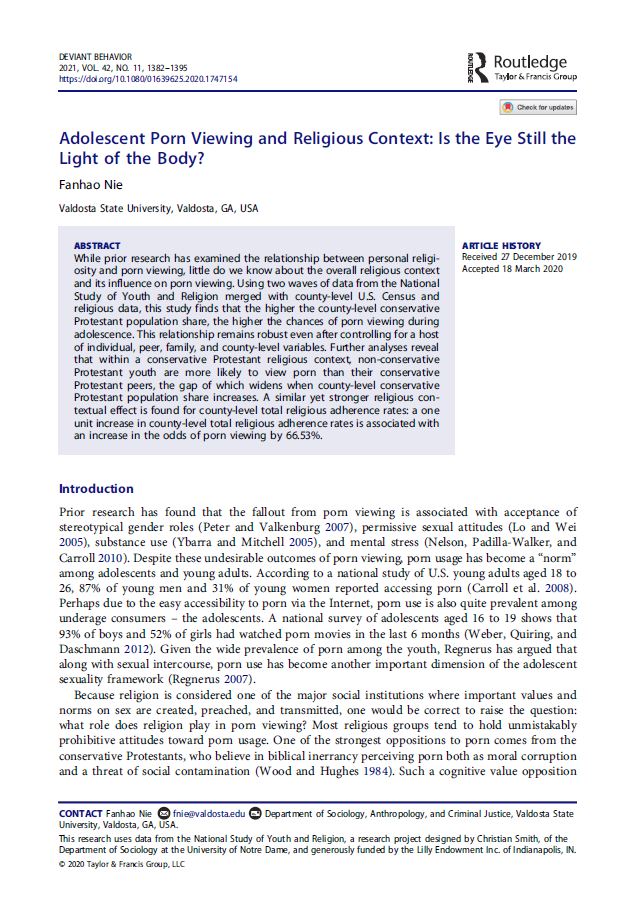Rates, Age, & Impact of Exposure to Pornography
Adolescent Porn Viewing and Religious Context
 Full Article Title: Adolescent Porn Viewing and Religious Context: Is the Eye Still the Light of the Body?
Full Article Title: Adolescent Porn Viewing and Religious Context: Is the Eye Still the Light of the Body?
Open Access: No
Abstract
While prior research has examined the relationship between personal religiosity and porn viewing, little do we know about the overall religious context and its influence on porn viewing. Using two waves of data from the National Study of Youth and Religion merged with county-level U.S. Census and religious data, this study finds that the higher the county-level conservative Protestant population share, the higher the chances of porn viewing during adolescence. This relationship remains robust even after controlling for a host of individual, peer, family, and county-level variables. Further analyses reveal that within a conservative Protestant religious context, non-conservative Protestant youth are more likely to view porn than their conservative Protestant peers, the gap of which widens when county-level conservative Protestant population share increases. A similar yet stronger religious contextual effect is found for county-level total religious adherence rates: a one unit increase in county-level total religious adherence rates is associated with an increase in the odds of porn viewing by 66.53%.
Relevance
“The results suggest that religious context matters: when a county has a higher conservative Protestant population share, youth living there, especially those who are not conservative Protestants, are more likely to view porn. A similar effect is also found between county-level total religious adherence rates and porn viewing: when a county has higher rates of religious adherence, youth in that county, regardless of one’s own religious identity, are more likely to watch porn. The results also show that the religious adherence effect is quite strong: a one unit increase in county religious adherence rates is associated with about a 67% higher risk of porn viewing during adolescence.” Furthermore, “On the practical side, the robust religious contextual effects on porn viewing show every indication that when it comes to the prevention of adolescent sexual deviance, simply having strict parenting and high personal religious devotion is not a sufficient measure to ensure that the adolescents will be protected from exposure to porn. Perhaps more changes need to be made in the traditional religious cultural values regarding sex. For instance, instead of simply stigmatizing and prohibiting sex, religious leaders may want to conduct more open dialogs with the youth congregants to help establish a more open-minded, objective perspective on the role and purpose of sex. As experience shows, the prohibitive and avoidant attitude toward sex held by religious authorities can stimulate those risk-prone, rebellious teens to intentionally seek out the tabooed information….Other measures involving the public health sector should also be considered for the wider community to better educate youth about sex. Prior research involving conservative Protestantism has shown that conservative ideology tends to perceive social issues as personal moral failures rather than social structural problems and thus social, secular interventions are unwarranted…Consequently, areas with more conservative Protestants tend to invest less financially in the community than their counterparts and thus fare worse in public health outcomes…When it comes to the prevalence of adolescent porn viewing in a conservative Protestant environment, it might be possible that such outcomes reflect the lack of public, community investment in educating the youth about sex.”
Citation
Nie, F. (2021). Adolescent Porn Viewing and Religious Context: Is the Eye Still the Light of the Body? Deviant Behavior, 42(11), 1382-1395. https://doi.org/10.1080/01639625.2020.1747154
